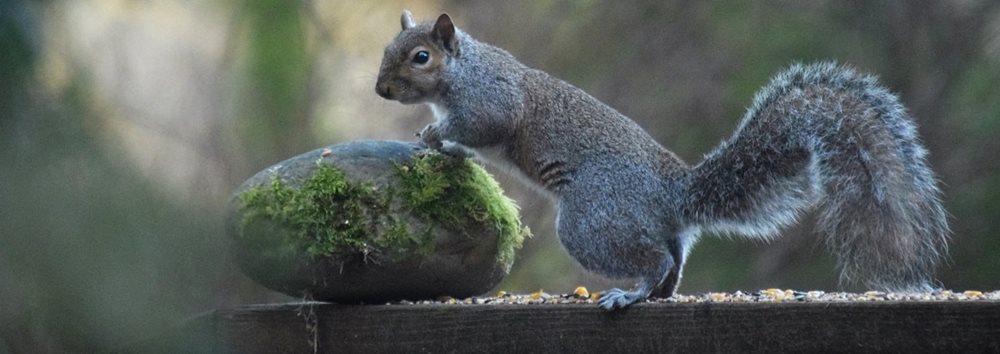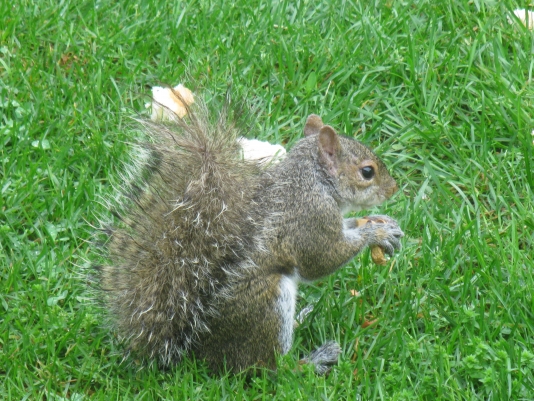
How to Identify and Remove Gray Squirrels
Description
Gray squirrels are a species of tree squirrel predominantly found in the Eastern United States. They frequently take up residence in woodland areas, suburban parklands, and residential neighborhoods where they are considered nuisance pests. However, gray squirrels are also important members of woodland ecosystems as they forage for nuts, seeds, and flower buds, which makes them vehicles of seed dispersal.
Need Help with Squirrel infestation?
Find a Critter Control near you.
Appearance

As their name would suggest, gray squirrels are typically gray in color and have white undertones on their bellies and tails . They range in size from 14 to 21 inches long and weigh approximately 20 ounces. In some northern populations, melanism occurs and individual squirrels appear entirely black in color.
Habitat
Since gray squirrels like to travel and forage almost exclusively among treetops, they prefer to live in mature forests. Ample populations of oaks, walnuts, and pines supply food for the rodents and help them survive harsh winter conditions. They build nests high in tree canopies out of leaves and twigs. Gray squirrels also move into hollow tree cavities for hibernation.
Entry
Are gray squirrels known to enter homes or yards?
As residential yards and parks provide them with their favorite food sources, gray squirrels frequently invade private properties. Telephone poles and roof lines serve as substitutes for their natural tree canopy habitats. They also enter homes through gaps in roofs and chimneys and build nests in attics.
Damage
Do gray squirrels harm people or property?
Even though gray squirrels are mostly beneficial to the environment, they are quite destructive when they enter homes. They may destroy electrical wiring and structurally important wooden beams during their attempts to build nests. Additionally, gray squirrels carry multiple parasites including fleas, ticks, lice, and roundworms. These pests spread diseases to both humans and domestic pets.
Control and Safety
The best way to keep gray squirrels out of homes is to seal all potential entryways. This includes holes in roofs, gaps along doorways, and torn weather stripping on windows. Additionally, topping trees and cutting back overgrown branches limits potential nesting areas. Certain repellents and noise deterrents can limit squirrel activity in the short-term but typically lose effectiveness over time.
Trapping and Removal
In order to successfully remove gray squirrels from private properties, individuals should call trained professional wildlife experts. Critter Control specialists have the equipment and knowledge to humanely remove any problematic gray squirrels and set up integrated pest management plans to help keep the rodents away in the future.
Learn more about squirrel removal.
Get them out.
Keep them out.®
Experiencing a wildlife or pest issue? We can help! Complete this form and your local Critter Control® office will contact you to assist.
- How to Get Rid of Squirrels
- Squirrels Entering Homes
- Squirrels in Attics
- Squirrels in Chimneys
- Squirrels on Roofs & in Soffits
- Squirrels in Walls
- Squirrels in Ventilation
- Squirrels in Gutters
- Squirrels in Crawl Spaces
- Squirrels in Yards or Gardens
- Squirrels in Trees
- Squirrels Digging Holes in the Ground
- How to Identify Squirrel Sounds
- Squirrel Tracks
- Squirrel Droppings
- Squirrel Trapping
- Squirrel Repellents & Deterrents
- Squirrel Appearance & Identification
- Species & Types of Squirrels
- Squirrel Life Cycle
- Baby Squirrels
- Squirrel Nest
- Dead Squirrels
- Squirrel Diet
- Diseases That Squirrels Carry
- Rabid Squirrels
- Do Squirrels Hibernate?
- Do Squirrels Bite?
- Squirrel Damage to Your House
- Squirrels vs. Rats
- Squirrels vs. Chipmunks